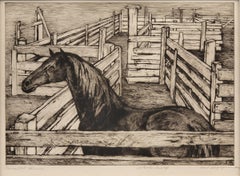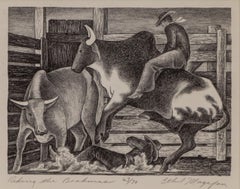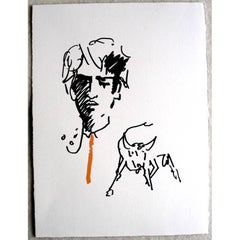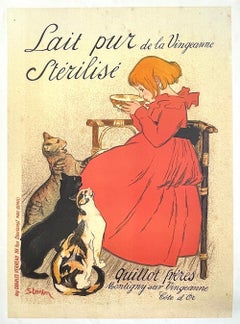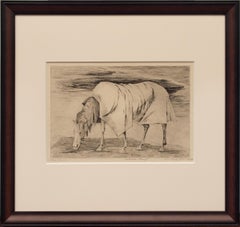Ethel Magafan Prints and Multiples
American, 1916-1993
Ethel Magafan Born Illinois, 1916
Died New York, 1993
Jenne and Ethel Magafan were identical twins, born in Chicago to a Greek immigrant father and a Polish mother. Due to health concerns about their father, the family moved to Colorado, living first in Colorado Springs and then in Denver. He was a proud supporter of their artistic ambitions but died suddenly 1932, a heavy blow to both of them. They attended East High School in Denver, where they found a mentor in their art teacher Helen Perry. She had studied at the Art Institute of Chicago but had later abandoned a career as an artist, making her all the more determined to help the Magafan twins succeed artistically.
While still in high school, the twins impressed artist Frank Mechau, and Helen Perry paid for their lessons with him. He subsequently invited them to apprentice with him at his Redstone studio. In 1936, Jenne won the Carter Memorial Art Scholarship and shared it with her sister so that they both could attend the Broadmoor Art Academy in Colorado Springs. Once they ran out of money, Mechau, now teaching there, hired them as assistants. Through their involvement at the Academy, the twins entered into careers as muralists, working at first with Mechau and then with Peppino Mangravite.
From 1937 to 1943, Ethel was commissioned to paint her first of seven government sponsored murals. Located in the US Post Office in Auburn, Nebraska, this commission made Ethel (at age 26) the youngest artist in America to receive such an honor. Denver Art Museum director Donald J. Bear once commented that “[Ethel and Jenne's] study of local detail makes them appear as little Bruegels of ranch genre – natural and unforced.”
As mural painting commissions diminished, Ethel began to do more easel painting for which she used a palette knife and tempera paints to great effect. After settling in California for five years, the twins permanently relocated to Woodstock, New York in 1945, where the sisters lived apart for the first time. Ethel developed an increasing focus within her work, particularly for horses and abstract landscapes. She met fellow artist Bruce Currie at an artist’s party, and the two were married in 1946.
The twins and their husbands went to Greece and Italy for a year when Jenne’s husband and Ethel were granted Fulbright Scholarships. Upon their return, Jenne died suddenly of a cerebral hemorrhage — a loss that Ethel would mourn deeply. With her sister gone, her landscapes became much more abstract, as she sought out the feeling of the scene rather than an exact representation. During the mid-fifties, she began to make annual trips to Colorado. Her stature within the art world was solidified in 1971 when the United States
©David Cook Galleries, LLCto
2
Overall Width
to
Overall Height
to
2
4
1,191
955
938
828
2
1
1
1
2
1
1
1
1
1
1
1
1
1
2
2
2
Artist: Ethel Magafan
Ethel Magafan “Corralled Horse” 1940s WPA-Era Modernist Etching, Artist’s Proof
By Ethel Magafan
Located in Denver, CO
Corralled Horse is a rare WPA-era modernist etching by acclaimed American artist Ethel Magafan, created in the 1940s. This artist’s proof depicts a lone dark horse within a wooden co...
Category
1940s American Modern Ethel Magafan Prints and Multiples
Materials
Etching
Ethel Magafan Modernist Rodeo Lithograph "Riding the Brahmas", Signed, Framed
By Ethel Magafan
Located in Denver, CO
Discover the raw energy and bold style of acclaimed Colorado artist Ethel Magafan with this original modernist lithograph titled Riding the Brahmas. This striking mid-20th-century pr...
Category
Mid-20th Century American Modern Ethel Magafan Prints and Multiples
Materials
Lithograph
Related Items
Jean Cocteau - The Elegant Toreador - Original Lithograph
By Jean Cocteau
Located in Collonge Bellerive, Geneve, CH
Original Lithograph by Jean Cocteau
Title: The Elegant Toreador
1961
Dimensions: 28 x 38 cm
Lithograph made for the portfolio "Gitans et Corridas" published by Société de D...
Category
1960s Modern Ethel Magafan Prints and Multiples
Materials
Lithograph
$949
H 11.03 in W 14.97 in D 0.04 in
Lait Pur de la Vingeanne Stérilisé, Young Girl, Cats, Vintage French Advertising
By Théophile Alexandre Steinlen
Located in Union City, NJ
Lait Pur de la Vingeanne Stérilisé is an offset lithographic print reproduced after the original 1894-95 Belle Epoque advertising poster created by Théophile Steinlen, printed using 4-color offset lithography on heavyweight archival paper. Lait Pur de la Vingeanne Stérilisé depicts a seated rosy cheeked young girl (the artist's daughter) wearing a long red dress sipping milk from a bowl as a group of envious animal friends - 3 cats...
Category
1980s Art Nouveau Ethel Magafan Prints and Multiples
Materials
Lithograph
$199 Sale Price
20% Off
H 35.25 in W 26 in
Original 1919, Give the World The Once Over in the United States Navy poster
Located in Spokane, WA
Original 1919 Give The World The Once Over in the United States Navy vintage poster. Archival linen backed. This poster presents itself very fine condition. The lower text por...
Category
1910s American Modern Ethel Magafan Prints and Multiples
Materials
Lithograph
$2,998
H 42 in W 28.5 in D 0.05 in
Jon Corbino, Montana Earthquake, 1936, lithograph
By Jon Corbino
Located in New York, NY
Works by Jon Corbino (1905-1964) feature drama. Here he's showing us the chaos produced by a major earthquake in rural Montana in 1936 -- an actual historical event.
The horses (ear...
Category
1930s American Modern Ethel Magafan Prints and Multiples
Materials
Lithograph
PERCY AT THE FRIDGE Signed Lithograph, Black Cat, Champagne, British Humor
By Beryl Cook
Located in Union City, NJ
PERCY AT THE FRIDGE is a hand drawn, pencil signed limited edition lithograph by the well known and loved British artist and humorist, Beryl Cook. Printed on archival Arches paper, 100% acid free, print size 28" x 21", image size 21 3/8" x 17". In this amusing depiction, "Percy" refers to the aristocratic black cat who sits patiently waiting in front of the open refrigerator stocked with fine champagne, canned salmon, milk, cream, roast turkey, and other gourmet delicacies all tempting items from his genteel mistress's offerings. She stands holding her spectacles, dressed in a jeweled tiara, long white evening gloves and light blue evening gown...
Category
1990s Contemporary Ethel Magafan Prints and Multiples
Materials
Lithograph
$1,551 Sale Price
34% Off
H 28 in W 21 in
Reginald Wilson, Horses
By Reginald Wilson
Located in New York, NY
Although this work is titled Horses. It nice to think it could be (Horses in a Field in Woodstock, NY), but it was printed by Will Barnet at the Art Students League, about 1938, and Wilson, who visited Woodstock with Arnold Blanche...
Category
1930s American Modern Ethel Magafan Prints and Multiples
Materials
Lithograph
Alexander Calder Circus Reproduction Lithograph After a Drawing
By (after) Alexander Calder
Located in Surfside, FL
(after) Alexander Calder
"Calder's Circus" offset lithograph on wove paper after drawings by the artist
Published by Art in America and Perls gallery in 1964 (from drawings done in the 1930's)
these range slightly in size but they are all about 13 X 17 inches (with minor variations in size as issued.) These have never been framed. The outer folio is not included just the one lithograph.
James Sweeny from the introduction “The fame of Calder’s circus spread quickly between the years 1927 and 1930. All the Paris art world came to know it. It brought him his first great personal success. But what was more important, the circus also provided the first steps in Calder’s development as an original sculptor”
Clive Gray wrote ”A visit to the studio of Alexander Calder led to the chance discovery of some hundred masterful circus drawings completed over thirty years ago. We publish, for the first time, a choice of sixteen from that group.” With signed introduction by Miro.
These whimsical drawings, done in the style of wire sculpture, include acrobats, clowns, jugglers, trapeeze artists, an elephant, dog and lion. they are great.
Alexander Calder is widely considered to be one of the most important American sculptors of the 20th century. He is best known for his colorful, whimsical abstract public sculptures and his innovative mobiles, kinetic sculptures powered by motors or air currents, which embraced chance in their aesthetic. Born into a family of accomplished artists, Calder's work first gained attention in Paris in the 1930s and was soon championed by the Museum of Modern Art in New York, resulting in a retrospective exhibition in 1943. Major retrospectives were also held at the Solomon R. Guggenheim Museum (1964) and the Museum of Contemporary Art, Chicago (1974). Calder’s work is in many permanent collections, most notably in the Whitney Museum of American Art, but also the Guggenheim Museum; the Museum of Modern Art; the National Gallery of Art, Washington, D.C.; and the Centre Georges Pompidou. He produced many large public works, including .125 (at JFK Airport, 1957), Pittsburgh (Carnegie International prize winner 1958, Pittsburgh International Airport) Spirale (UNESCO in Paris, 1958), Flamingo and Universe (both in Chicago, 1974), and Mountains and Clouds (Hart Senate Office Building, Washington, D.C., 1976). Although primarily known for his sculpture, Calder was a prodigious artist with a restless creative spirit, whose diverse practice included painting and printmaking, miniatures (such as his famous Cirque Calder), children’s book illustrations, theater set design, jewelry design, tapestry and rug works, and political posters. Calder was honored by the US Postal Service with a set of five 32-cent stamps in 1998, and received the Presidential Medal of Freedom, posthumously in 1977, after refusing to receive it from Gerald Ford one year earlier in protest of the Vietnam War.
Calder moved to New York and enrolled at the Art Students League, studying briefly with Thomas Hart Benton, George Luks, Kenneth Hayes Miller, and John Sloan. While a student, he worked for the National Police Gazette where, in 1925, one of his assignments was sketching the Ringling Bros. and Barnum & Bailey Circus. Calder became fascinated with the action of the circus, a theme that would reappear in his later work.
In 1926, Calder moved to Paris, enrolled in the Académie de la Grande Chaumière, and established a studio at 22 rue Daguerre in the Montparnasse Quarter. In June 1929, while traveling by boat from Paris to New York, Calder met his future wife, Louisa James (1905-1996), grandniece of author Henry James and philosopher William James. They married in 1931. While in Paris, Calder met and became friends with a number of avant-garde artists, including Fernand Léger, Jean Arp, and Marcel Duchamp. Cirque Calder (on view at the Whitney Museum of American Art at present) became popular with the Parisian avant-garde. He also invented wire sculpture, or "drawing in space," and in 1929 he had his first solo show of these sculptures in Paris at Galerie Billiet. Hi! (Two Acrobats) in the collection of the Honolulu Museum of Art is an early example of the artist's wire sculpture. The painter Jules Pascin, a friend of Calder's from the cafes of Montparnasse, wrote the preface to the catalog. A visit to Piet Mondrian's studio in 1930, where he was impressed by the environment-as-installation, "shocked" him into fully embracing abstract art, toward which he had already been tending.
Dating from 1931, Calder’s sculptures of discrete movable parts powered by motors were christened “mobiles” by Marcel Duchamp, a French pun meaning both "motion" and "motive." At the same time, Calder was also experimenting with self-supporting, static, abstract sculptures, dubbed "stabiles" by Jean Arp in 1932 to differentiate them from mobiles.
Public commissions increasingly came his way in the 1960s. Notable examples are .125 for JFK Airport in 1957, Spirale for UNESCO in Paris 1958 and Trois disques, commissioned for Expo 67 in Montreal, Quebec, Canada. Calder's largest sculpture at 25.7 meters high was El Sol Rojo, constructed outside the Aztec Stadium for the 1968 Summer Olympics "Cultural Olympiad" events in Mexico City. Many of his public works were commissioned by renowned architects; I.M. Pei commissioned his La Grande Voile (1966), a 25-ton, 40-foot high stabile for the Massachusetts Institute of Technology.
Part of Calder's repertoire includes pivotal stage sets for more than a dozen theatrical productions, including Nucléa, Horizon, and most notably, Martha Graham’s Panorama (1935), a production of the Erik Satie symphonic drama Socrate (1936), and later, Works in Progress (1968).
In addition to sculptures, Calder painted throughout his career, beginning in the early 1920s. He picked up his study of printmaking in 1925, and continued to produce illustrations for books and journals.As Calder’s professional reputation expanded in the late 1940s and 1950s, so did his production of prints. Masses of lithographs based on his gouache paintings hit the market, and deluxe editions of plays, poems, and short stories illustrated with fine art prints by Calder became available for sale.
One of Calder's most celebrated and unconventional undertakings was a commission from Dallas-based Braniff International Airways to paint a full-size Douglas DC-8-62 four-engined jet as a "flying canvas."
Calder created over 2,000 pieces of jewelry over the course of his career, many of them as gifts for friends and relatives. For his lifelong friend Joan Miró, he set a shard of a broken porcelain vessel in a brass ring. Peggy Guggenheim received enormous silver mobile earrings and later commissioned a hammered silver headboard...
Category
1930s American Modern Ethel Magafan Prints and Multiples
Materials
Lithograph
Alfred Bendiner, Horse Laugh, mid-century equine humor
By Alfred Bendiner
Located in New York, NY
Alfred Bendiner (1899-1964) was trained as an architect but worked as an artist throughout his career. He was a noted lithographer, as well an author, muralist, and caricaturist. The...
Category
Mid-20th Century American Modern Ethel Magafan Prints and Multiples
Materials
Crayon
OUT OF THE SHADOWS Signed Lithograph, Leopard Portrait, Wildlife Jungle
By Sydney Taylor
Located in Union City, NJ
OUT OF THE SHADOWS by the British wildlife artist Sydney Taylor, is an original hand drawn limited edition lithograph printed using traditional hand lithography techniques on archiva...
Category
1980s Contemporary Ethel Magafan Prints and Multiples
Materials
Lithograph
$398 Sale Price
20% Off
H 21.5 in W 29.5 in
SLAVE TO FASHION, Signed Lithograph, City Woman Walking Dog, Animal Print Coat
By Robin Morris
Located in Union City, NJ
SLAVE TO FASHION by the woman artist Robin Morris, is an original limited edition lithograph printed using hand lithography techniques(not a photo reproduction or digital print) on a...
Category
1980s Art Deco Ethel Magafan Prints and Multiples
Materials
Lithograph
$448 Sale Price
42% Off
H 39 in W 26 in
Composition - Lithograph
By (after) Raoul Dufy
Located in Collonge Bellerive, Geneve, CH
(after) Raoul Dufy
Lithograph after a watercolor, published in the book "Lettre à mon peintre Raoul Dufy." Paris, Librairie Académique Perrin, 1965.
Printed signature
Di...
Category
1940s Fauvist Ethel Magafan Prints and Multiples
Materials
Lithograph
Armadillo: An Original 19th Century Hand-colored Lithograph by John J. Audubon
By John James Audubon
Located in Alamo, CA
This is an original 19th century John James Audubon hand-colored lithograph entitled "Nine-banded Armadillo", No. 30, Plate CXLVI, from Audubon's "Viviparous Quadrupeds of North Amer...
Category
Mid-19th Century Naturalistic Ethel Magafan Prints and Multiples
Materials
Lithograph
$620 Sale Price
20% Off
H 7 in W 10.38 in
Previously Available Items
Lone Horse ( Artist Proof), 1940s American Modernist Portrait of Horse Print
By Ethel Magafan
Located in Denver, CO
"Lone Horse (Artist Proof)", is an etching on paper by western artist Ethel Magafan (1916-1993) of a single dark horse standing outside eating in a field with a blanket on and dark clouds in the background. Presented in a custom frame, outer dimensions measure 19 x 20 ¼ inches. Image size is 8 x 12 inches.
Piece is clean and in very good condition - please contact us for a detailed condition report.
Provenance: Estate of the Artist, Ethel Magafan
Expedited and international shipping is available - please contact us for a quote.
About the Artist:
Ethel Magafan
Born 1916
Died 1993...
Category
1940s American Modern Ethel Magafan Prints and Multiples
Materials
Paper, Etching
Ethel Magafan prints and multiples for sale on 1stDibs.
Find a wide variety of authentic Ethel Magafan prints and multiples available for sale on 1stDibs. You can also browse by medium to find art by Ethel Magafan in etching, paper and more. Much of the original work by this artist or collective was created during the 1940s and is mostly associated with the modern style. Not every interior allows for large Ethel Magafan prints and multiples, so small editions measuring 23 inches across are available. Customers who are interested in this artist might also find the work of Lynd Ward, Alfred Bendiner, and Bernard Brussel-Smith. Ethel Magafan prints and multiples prices can differ depending upon medium, time period and other attributes. On 1stDibs, the price for these items starts at $880 and tops out at $880, while the average work can sell for $880.
